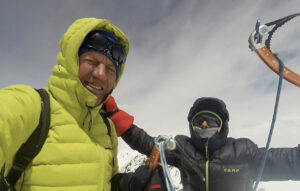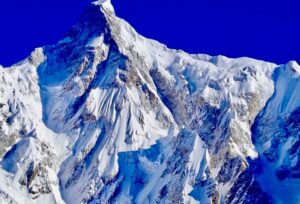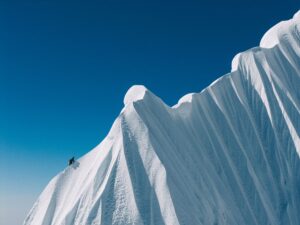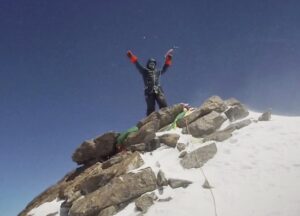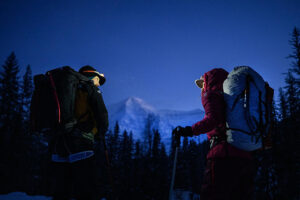A sharp, aesthetic 6,000’er in Pakistan’s Karakoram, Mitre Peak faces Broad Peak at the spot where the Baltoro Glacier bifurcates. On the left, the Godwin-Austen Glacier ascends toward K2. On the right, the Upper Baltoro continues toward the Gasherbrums.

The height of Mitre Peak depends on your source. Most put it at 6,010m or 6,013m, but a few list it slightly higher at 6,025m. This haunting, beautiful peak has been climbed only once, in the summer of 1980, by the Italian-French mountaineer Ivano Ghirardini.
Ghirardini’s career was as intense as it was outstanding. Yet he shuns the spotlight. If you don’t ask him, he doesn’t talk. He doesn’t brag. Perhaps for this reason, only a few know the full story of this lone ascent of Mitre Peak. We spoke to Ghiradini about this special climb.

Ivano Ghirardini. Photo: Waligora
A savage soul
Ghirardini might be described as an instinctive climber. Inspired by history’s great alpinists, he carried out pioneering climbs in the late 1970s and early 1980s. A great defender of transparency and sincerity, and no friend of the ostentatious, he has been a man of action, not words.
He climbed for himself, for that magical union with the peaks and to find mental calm. Hard as a rock, yet sensitive, like a beating heart that throws itself at the foot of difficult routes. That’s how he is, a savage soul. That is our impression of the man following several conversations about mountaineering and its meaning.

Ghirardini soloing in the Alps. Photo: Alchetron
Before Mitre Peak
Now 69, his memories are filled with the beauty of the mountains. But in 1975, at the age of 21, he became the first person to climb the North Face of the Grandes Jorasses alone in winter. He soloed it a second time in January 1978 and also soloed the North Faces of the Matterhorn and the Eiger, also in winter. He thus became the first person to complete the winter solo North Face Trilogy, finishing before Tsuneo Hasegawa.
From those adventures, Ghirardini developed a great appreciation and admiration for his Japanese rival. After Hasegawa died in the Karakoram in 1991, Ghirardini went to Ultar Sar to pay homage.

The North Face of the Matterhorn. Photo: Glenmore Lodge
In 1979, Ghirardini was part of a French team that tried to climb the feared Magic Line on K2. High on the mountain, bad weather forced his partners down one by one. Eventually, Ghirardini bivouacked alone at 8,350m, without supplemental oxygen and without a tent. In his snow cave, he planned a solo summit push the next day. But it was not to be. The storm was too bad, and he too had to descend.

Mitre Peak. Photo: Wikipedia
A beautiful dream
During the K2 expedition, Ghirardini was “shocked” by the beauty of unclimbed Mitre Peak. “There are summits that are the archetype of perfection, as much by the purity of the forms, which stand straight towards the sky, as by the feelings they inspire. Surrounded by colossal peaks that exceed or approach 8,000m, Mitre Peak is of incomparable elegance. I loved it as soon as I saw it,” Ghirardini wrote in his 1996 book, Thanatos.
When he returned home from K2, he hung a photo of Mitre Peak on the wall in front of his bed. He dreamed of the first climbers of La Meije, the Viso, the Drus, of Aiguille Noire de Peuterey. He daydreamed about mountaineers like Whymper and immersed himself “in the spirit of the mountaineering pioneers.” His desire to return to Karakoram grew.

Another view of Mitre Peak. Photo: Karakoram
At the end of 1979, he received authorization to climb Mitre Peak. He found some sponsors who believed in his project and cobbled together a minimalist expedition budget. By 1980, everything was ready. He planned to go alone, but his wife at the time, Marie Jeanne, gave him an ultimatum: “Take me with you or it’s divorce!” At the end of April 1980, the couple left France.

One of the Pakistani porters during the approach. Photo: Ivano Ghirardini
The approach
They hired eight porters, compared with the 1,400 porters of the previous year’s K2 expedition. Ghiradini felt like a “fly facing a mammoth.” The porters were very kind to the couple.
“If there’s truth, it is not in books but in the lives of little people. Their fight for survival gives them greatness and beauty. They are truly the people of God,” Ghirardini wrote of the porters.
During their approach, Ghirardini decided to stop at Urdukas. There, he left Jeanne and the porters for a few days. He decided to make an attempt on the Nameless Tower, which was technically illegal as he did not have a permit.
After two days, he reached the base of the Tower. But bad weather arrived and he had to abort. After a week, he went back to Urdukas, and he, Marie Jeanne, and the porters continued their approach to Mitre Peak. When they arrived at base camp, the porters left for home.

Marie Jeanne during the approach. Photo: Ivano Ghirardini via Montagnes Magazine
Locals told Ghiradini that two illegal attempts had been made on the peak, both by American expeditions. They said that both had failed.
The couple decided to rest for several days at base camp. “It was Eden,” Ghiradini says. They did yoga watching the mountain. Ibexes strolled past their camp. “It was a sign that these mountains accepted us. I felt that we would succeed,” Ghirardini wrote.
The ascent
On the morning of May 30, 1980, Ghirardini decided that the time was right. In a couple of hours, he prepared all the materials he needed: two ropes, 15 pitons, a bivy tent, a sleeping bag, a stove, and food for five days. Together, they totalled 15kg.
During his time at base camp, he had noticed a couloir on the right side of the mountain. He would try that line. Crossing the Baltoro in the afternoon was difficult, and he only made the foot of the peak at 9 pm. After a few hours of rest, he started the ascent that night.

Part of the climb. Photo: Ivano Ghirardini
At 1 am on May 31, he started climbing the couloir. As with most sharp peaks, it featured bad rock and avalanche danger. By 10 am on June 1, he had ascended 800m without stopping. He reached a small rock in the middle of the couloir, tired after nine hours of climbing.
He hesitated, wondering whether to continue or rest. Suddenly, he heard a loud voice yelling at him: “Stop there and make some tea!” Of course, nobody was there, and Ghirardini thought that he might have gone mad.

The upper part of Mitre Peak. Photo: Ali Usman Baig
Terrifying moments
He stopped and tied himself in. A moment later, as he was looking up, he realized that a huge avalanche was beginning. He only had seconds to react.
He screamed and pressed up against the rock, squeezing the pitons tightly in his hands, trying to nail them further into the rock.
The avalanche hit him, but fortunately, he wasn’t ripped off. Instead, he slammed hard against the rock. Powdered snow filled his lungs.
When he recovered, he could see that the entire slope had come down. “If that voice hadn’t ordered me to stop, I would be dead, gone forever, like Mummery on Nanga Parbat or Hermann Buhl on Chogolisa,” Ghirardini explained. Without the rock for shelter, he surely would have been swept into the abyss.

Mitre Peak. Photo: Nancy J. Hansen
At midnight, he continued ascending. After reaching an area of mixed terrain, he waited for sunrise. He continued over a pass behind the peak, which he named Crescent Moon Ridge, because of its shape.
He was still 300m from the summit, and Ghirardini decided to leave his gear behind for this final section.
The last section
The summit part was the most difficult and technical of the climb. Fifty meters below the top, he had to stop to rest without much protection, in freezing conditions.
“I remember the calm during the ascent,” Ghirardini said. But ugly clouds were approaching. He remembers the last section before the summit as totally vertical.
“It’s very nice. About 15m V+/A1 bad rock,” he recalls. “When you catch the summit ridge of Mitre, it is so nice to discover the other face of the mountain and see how sharp it is too. It looks like the Aiguille de la Republique in the Alps, but with poor rock.” The ice and snow were 65° (UIAA V+).
Before reaching the small summit where the sharp faces meet, he remembers the very pure, light air. “It was a strange calm. Strange because there was light, wind, clouds, sun…and the feeling of calm and freedom. I was sure of success because I felt protected up there.”
The top and the descent
On June 2, he reached the summit. “The top was narrow, barely wider than a shoe. I just straddled a small spot, as if I was sitting on a horse. One of my legs was hanging down one side of the mountain, and the other leg on the other side.”
He put a small French flag on top, ate some dried fruit, and started to descend in a violent wind. At the bottom of the summit section, the wind calmed and he stopped to rest.

Mitre Peak at night. Photo: Pirusaein/Instagram
The night descent was like diving into an abyss. On June 4, he reached base camp, where Marie Jeanne was waiting for him with pancakes and apricot jam. He slept for hours. The tension of the climb left him exhausted. The two decided to stay at the base camp for one more week, eating and sunbathing naked, surrounded by giant peaks. “Our tent was on a field of grass and flowers above the moraine. This was paradise,” Ghirardini remembers.
A week later they left base camp and Ghirardini attempted K2 again. He tried to push for the summit alone, reaching 7,000m before aborting. On his return to civilization, the Pakistani authorities fined him for wandering around the Karakoram without permission.

Ivano Ghirardini. Photo: Alchetron
Ghiradini continued to climb and explore. In January 1981, he made the first solo ascent of the south face of Aconcagua. And in the winter of 1982, he made a solo attempt on Makalu via the very difficult West Buttress. He climbed in alpine style, with just 120m of rope and a 25kg backpack. But bad weather stopped him short. There, on Makalu, he decided to leave extreme mountaineering behind.
Mitre Peak was last attempted by a Polish team in 2020, but it remains unrepeated.

